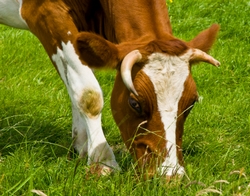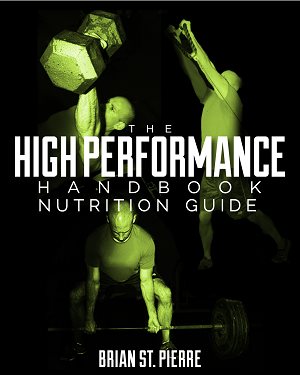Grass-fed or Conventional: What’s the Deal?
Filed under: General Health, Nutrition
In my mind meat, eggs, and dairy products from pasture-raised animals are ideal for your health. Compared with conventional feedlot-raised animals, they offer you a much greater nutrient profile. They are richer in antioxidants and vitamins; including vitamins A, C, D, E, and K. Additionally, they do not contain traces of added hormones, antibiotics or other drugs and they do not eat grass that has been treated with herbicides and pesticides.
There are a number of nutritional differences between the meat of pasture-raised grass-fed animals and conventional feedlot-raised animals. Meat from grass-fed cattle, sheep, and bison are leaner, and can have up to one third as much fat content as a similar cut from a grain-fed animal. Not only are grass-fed pasture-raised animals leaner, the fat content of their meat is of a higher quality. Meat from grass-fed animals has two to four times more omega-3 fatty acids than meat from grain-fed animals. Omega-3 fats can reduce blood pressure, decrease LDL, decrease triglycerides, slow the growth of a wide array of cancers, regulate heartbeat, are essential for your brain, eyes and nerves, and people with diets rich in omega-3 fats are less likely to suffer from depression, schizophrenia, attention deficit disorder, or Alzheimer’s disease.
Allowing animals to graze on pasture provides higher amounts of omega-3 fats because omega-3′s are formed in green leaves and algae. Sixty percent of the fatty acids in grass are omega-3′s. Grain-fed animals are not given access to foods rich in omega-3′s, so their meat content contains little to none.
The same issue arises with hens and their eggs. Conventionally-raised chickens are housed indoors and are deprived of greens, mainly being fed corn, causing their meat and eggs to become artificially low in omega-3 fats. Eggs from pasture-raised hens can contain up to ten times more omega-3 fats than conventionally raised hens! Only 40% of Americans consume enough omega-3 fats, and 20% have blood levels so low that they cannot be detected. Switching to meat, dairy and eggs from grass-fed and pasture-raised animals is one way to increase your intake of these vitally important omega-3′s.
Another benefit of eating grass-fed pasture-raised animals is their CLA content. CLA is another healthy fat called conjugated linoleic acid. Meat and dairy from grass-fed animals provide the richest source of CLA on the planet, containing three to five times more CLA than feedlot-raised animals. CLA has been found to greatly reduce tumor growth in animals, and possibly in humans as well. In a Finnish study women who had the highest levels of CLA in their diet had a 60% lower risk of breast cancer than those with the lowest. Simply switching from conventionally-raised grain-fed meat and dairy to pasture-raised grass-fed versions places women in the lowest risk category.
Locating pasture-raised grass-fed animals may seem daunting, but with only a little searching you should be able to locate some near you. Websites like eatwild.com and localharvest.org can help you find local farms, farmer’s markets and natural food stores. You can either choose to eat healthy animals that get sunshine, exercise and consume a beneficial diet, or animals that spend most of their lives tightly enclosed, hardly move and consume diets that will eventually kill them, the choice is yours.
Check out the BSP Training & Nutrition Newsletter!
You will get immediate access to:
- Weekly updates and exclusive content.
- The 20-page report "The Truth About Saturated Fat & Cholesterol."
- Become more awesome!
Posted on April 5th, 2010 by Brian St. Pierre
8 Comments






April 5th, 2010 at 5:30 pm
Brian,
Other issues with conventional feedlot animal products vs. pastured products aside, for someone consuming wild salmon 2 or more times a week and also using a fish oil supplement wen not eating fish, would there be a massive impact between fatty acid impact if the feedlot meat was still the leanest available cut/excess fat was trimmed off?
And as far as the omega 3′s in pasture products, is this in the form of EPA and DHA as in fish, as opposed to the ALA? I’m guessing the animal converts the ALA in grass into the forms we specifically want.
April 5th, 2010 at 7:26 pm
I agree with Mr. St. Pierre that Grass fed animals are, in general, better fgr you than conventionally produced animal products. However, that’s because conventionally raised food animals are, for lack of a better word, spooky.
Still, from an environmental point-of-view, organically raised food animals still impact our earth more severely than plant-based foods. Raising animals (even if raised organically and humanely) still requires A LOT of land, water, and energy. It is a fact that, if given an acre of land, one would be able to produce MUCH MORE plant foods compared with animal foods, and the impact on the environment would be less.
RE: CLA. As Brian mentioned, there are a lot of good studies to support the benefits of CLA in animals such as mice; however, the human data is scant at best. AT BEST, the benefits of CLA on human health is modest. So CLA is the least of my concerns when it comes to nutrition. Here are a few links with more info.
http://www.ncbi.nlm.nih.gov/pubmed/16477173
http://www.ajcn.org/cgi/content/abstract/85/5/1203
http://www.ncbi.nlm.nih.gov/pubmed/11578253
As Mr. St. Pierre has mentioned previously, just eating whole foods, and limiting consumption of highly-processed white carbohydrates is the key to optimal nutrition. The rest of the stuff are simply silly details that are not worth discussing.
April 7th, 2010 at 10:42 am
Jeff,
There is certainly much more to the equation than just fatty acid content. Grass-fed beef also has higher vitamin A and vitamin E content, higher antioxidant content, glutathione and super oxide dismutase content, does not contain any hormones or antibiotics, etc. It is certainly not just about the leanest cut, that should not be your determining factor, you don’t cut the fat off of salmon do you?
The omega-3 content is mainly EPA/DHA. ALA is the plant-based form that animals convert.
Mr. B,
Yes animals do require a lot of land, but they are a part of the life cycle. Without the animal excrement to fertilize the land, how would you grow all of those crops? Balance is the key.
As for CLA, the links you posted are merely about its connection to weight reduction. You are right, the link there is certainly all over the map. What I was talking about was CLA and its anti-cancer benefits which have been shown repeatedly in not only animals, but in-vitro studies of humans cells as well. It has not progressed to full-fledged long-term human studies, but it is certainly very promising, that you can not deny. Here are few links with more info for you:
http://www.ncbi.nlm.nih.gov/pubmed/20363115
http://www.ncbi.nlm.nih.gov/pubmed/20143104
http://www.ncbi.nlm.nih.gov/pubmed/20089779
http://www.ncbi.nlm.nih.gov/pubmed/20063697
http://www.ncbi.nlm.nih.gov/pubmed/20043266
There are more, just go to pubmed and type in cla cancer.
April 9th, 2010 at 5:36 pm
Round two of blog bashing eh Mr. B?
I want to totally respect your way of life, its your choice what you put into your body, BUT and I will say it again, BUT, I don’t; becuase you have to also keep an open mind about other opinions and choices, with respect. You do neither!
Here is are a couple questions for you…
Do you train anyone? Athletes, weekend warriors, youth, adults?
Are you a registered dietitian?
Where is your blog, website, LLC?
Is your full time job being “that guy” on the internet?…
You are disrespecting not only BSP but his readers as well, no one wants to see you bash his credentials or his POV’s because you think you are in the right…STOP, its annoying.
May 20th, 2010 at 5:28 pm
[...] While it is amazing that is has taken this long for something like this to be truly analyzed, actually separating processed versions of red meat from things like steak and other non-processed cuts has actually provided the proof we have all known to be there: that the real problem with red meat and heart disease is from processed shit. I bet it would make even more of a difference if they separated conventional red meat from grass-fed. [...]
September 8th, 2010 at 10:03 am
[...] researching the benefits of grass-fed meat for my nutrition guide for Eric Cressey’s new book, I came across a brand-new study that I [...]
April 11th, 2014 at 7:38 pm
[…] http://brianstpierretraining.com/index.php/grass-fed-or-conventional-whats-the-deal/ […]
July 8th, 2014 at 2:13 am
I see a lot of interesting content on your website.
You have to spend a lot of time writing, i know how to
save you a lot of work, there is a tool that creates unique, SEO friendly articles
in couple of minutes, just type in google – laranita’s
free content source